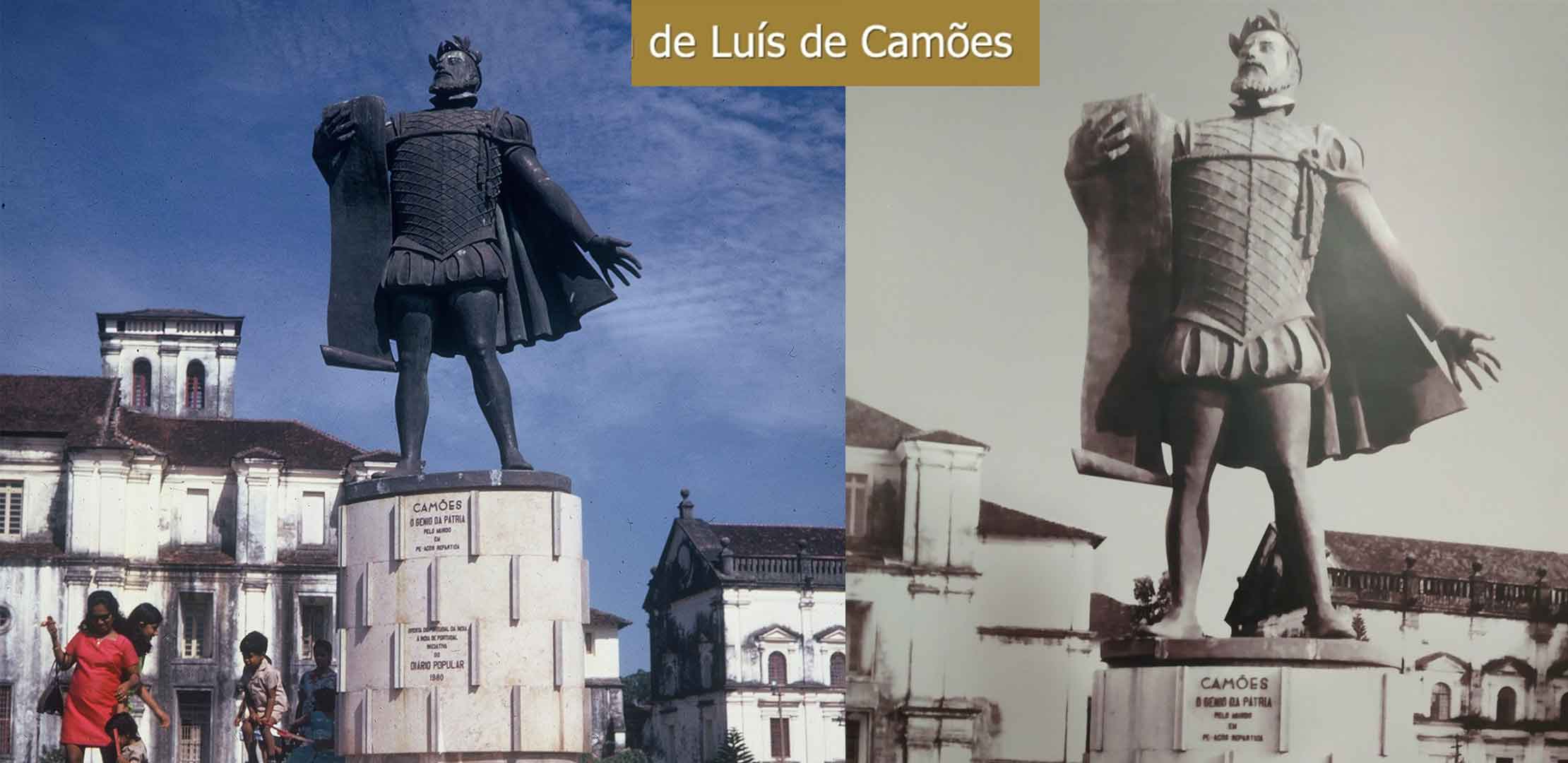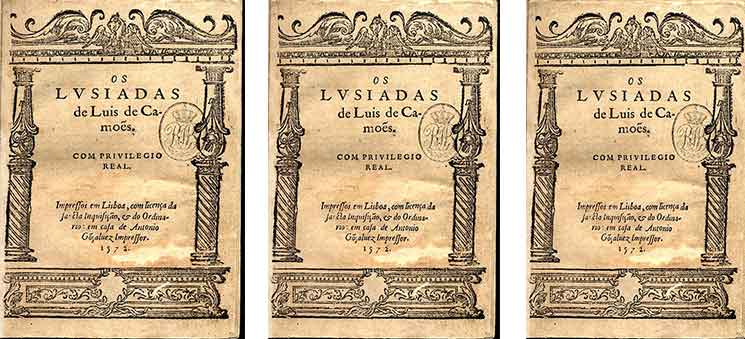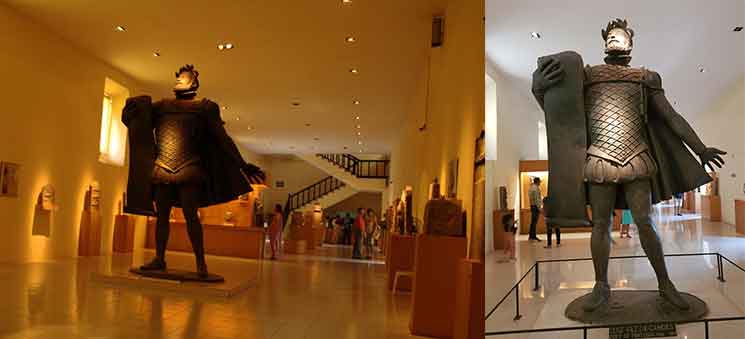When statue of Portuguese poet Louis Camoes in Old Goa was removed...
When statue of poet Louis Camoes in Goa was removed...

The Black Lives Matter protests in the USA and Europe have called for removal of statues of some persons including Winston Churchill for their alleged dubious roles in treatment to the black community. This reminds me how a statue of celebrated literary giant Luis Vaz de Camoes in Old Goa was removed in 1980s, two decades after Goa was liberated from the Portuguese regime. There is an important circle in Old Goa no visitor to this former capital of Goa under the Portuguese regime will ever miss. This circle is at the entrance of the impressive Se Cathedral, the white 17th century edifice and the largest church in Old Goa.
This circle comes into prominence especially on December 3, the feast of St. Francis Xavier, and once a decade exposition of the relics of this patron saint of Goa. At the centre of the circle was once a pedestal. A huge statue of Portuguese poet Luis Vaz de Camoes placed on the pedestal was the centre of attraction at the walking plaza at the historic cathedral. The poet stood there, with his face up, holding in his hand scrolls of his epic, Os Lusíadas .
The imposing 3.6 meters high bronze statue of Luis Vaz de Camoes (1524/25 – 20 June, 1580) with the impressive background of Se Cathedral would have served as an ideal spot for selfies or photo ops. But not many people of my generation would have in their albums their photos captured at this site. I moved to Goa in 1978 but do not have a single photo taken near this poet’s statue at this picturesque site. This is because clicking photographs was not easily possible and affordable for common people till early 1980s, the period till the Portuguese bard’s statue was allowed the honour of occupying the high pedestal.
Old Goa is one of the most popular tourist destinations in Goa. The statue of a Portuguese national – a poet but in Portuguese language – continued to occupy the high pedestal even after Goa’s liberation in December 1961. Significantly, the statue was erected in Old Goa in 1960, just a year before Prime Minister Pandit Jawaharlal Nehru ordered military action to liberate Goa from the Portuguese rule. The marble plaque on the pedestal carried in Portuguese language name and contribution of Luis Camoes.
During my college days, I visited Old Goa several times but it never occurred to me that the legacy of this impressive statue, like Portuguese – the administrative language of this tiny territory for four centuries – would soon be wiped out. The area around the circle was later renovated with a beautiful landscape in view of the increasing number of tourists to this historic place. Statues of many governor generals of the Portuguese regime in Goa including Afanso de Albuquerque, Vasco de Gama from various prominent locations were shown the place they deserved after Goa’s liberation – the museums and archives.
Murmurs against keeping the Portuguese poet’s statue at the high pedestal in Old Goa had started getting louder in early 1980s. A group of freedom fighters and others calling themselves as nationalists demanded that the statue of the foreign national, who praised Portuguese imperialism, be removed from the site. It was even alleged that Luis Camoes had referred to Indians as dogs in his magnum opus epic, Os Lusíadas ("The Lusiads"), an allegation reputed by many.

Luis Vaz de Camoes has been hailed as Shakespeare, Homer or Kalidas of Portuguese language and national poet of Portugal. He had spent many years in Goa. But the group of the nationalists in Goa perceived Camoes as a relic of the past Portuguese imperialism and therefore saw no reason why his statue should occupy an honourable place after Goa's liberation. There were of course some voices, lauding the contribution of the giant litterateur.
Os Lusíadas has been translated into several languages Camoes is called as the greatest poet in Portuguese language. His tomb in Lisbon, Portugal, is a national monument, visited by a large number of dignitaries and others. But those demanding removal of the poet’s statue were not impressed. The clamour for the statue’s removal was increasing. The issue was even raised in Indian Parliament. The Goa government was in a fix.
This atmosphere prevailing in Goa flashed before my mind when there was a prolonged controversy over the statue of Dadoji Kondadeo along with young Shivaji Maharaj and his mother Jijamata at the Lal Mahal in Pune. Some groups had questioned the very role of Dadoji Kondadeo in the life of Shivaji Maharaj and therefore demanded removal of his statue. Ultimately, Kondadeo statue was removed in the presence of a large police personnel which ended the row.
In the case of poet Luis Vaz de Camoes, one morning in 1983, it was found that a blast was carried out to destroy the statue. It was a job carried out by amateur persons. The statue had remained intact at the pedestal but the blast, apparently carried out with gelatin sticks, had managed to rip open the throat area of the statue. Nevertheless the amateurish job on the statue accomplished its mission.
The blast job on the statue came as a blessing in disguise for the troubled Goa government led by Pratapsingh Rane. The public works department swiftly made arrangements to shift the statue to the museum of the Archaeological Survey of India, located just across the road, on the premises of the Bom Jesu Basilica. A major headache for the administration and security authorities was thus solved once for all. Now the statue of poet Luis Vaz de Camoes at the museum is among scores of statues of heroes in Goan, Portuguese history and may hardly attract special attention of anyone. If you ever happen to visit this museum, remember, this statue of Luis Camoes now relegated into oblivion was once at the centre of attraction in Old Goa.
 Ravindra Kelekar's writing
Ravindra Kelekar's writing
It is a fallacy to believe that we are perpetuating the memory of men who have passed away by erecting their statues. It is a bigger fallacy to think that we can erase the legacy of great men by removing the statues that have been installed.
There was a very artistic statue of Luis de Camoes in Old Goa. Some of us pseudo nationalists amongst us decided that this poet, who spoke so highly of the Portuguese empire, did no deserve to stand on Goan soil, so they had the statue removed. This was meant as a retaliatory gesture. Whether it hurt the Portuguese empire, one cannot tell,but I must confess that one Ravindra Kelekar was extremely upset. He felt that Goa was insulting all the poets of the world by this act and, dashed off four or five articles explaining the position Camoes occupied in world literature. But would anyone listen to him? These pseudo nationalists and freedom fighters listen to those who fling crumbs of favour and position before them, not to voices that try to make them think. There is a force called fate or Destiny that operates in this world, and sometimes this force takes revenge on us for the crime we commit.Some years after this statue was pulled down in Old Goa, the President of India, on a State visit to Portugal, laid a wreath at the grave of Camoes. I feel these pseudo nationalists should have demanded that the President resign for this act. Or they should have ended their lives in the Mandovi as a mark of protest.

The Black Lives Matter protests in the USA and Europe have called for removal of statues of some persons including Winston Churchill for their alleged dubious roles in treatment to the black community. This reminds me how a statue of celebrated literary giant Luis Vaz de Camoes in Old Goa was removed in 1980s, two decades after Goa was liberated from the Portuguese regime. There is an important circle in Old Goa no visitor to this former capital of Goa under the Portuguese regime will ever miss. This circle is at the entrance of the impressive Se Cathedral, the white 17th century edifice and the largest church in Old Goa.
This circle comes into prominence especially on December 3, the feast of St. Francis Xavier, and once a decade exposition of the relics of this patron saint of Goa. At the centre of the circle was once a pedestal. A huge statue of Portuguese poet Luis Vaz de Camoes placed on the pedestal was the centre of attraction at the walking plaza at the historic cathedral. The poet stood there, with his face up, holding in his hand scrolls of his epic, Os Lusíadas .
The imposing 3.6 meters high bronze statue of Luis Vaz de Camoes (1524/25 – 20 June, 1580) with the impressive background of Se Cathedral would have served as an ideal spot for selfies or photo ops. But not many people of my generation would have in their albums their photos captured at this site. I moved to Goa in 1978 but do not have a single photo taken near this poet’s statue at this picturesque site. This is because clicking photographs was not easily possible and affordable for common people till early 1980s, the period till the Portuguese bard’s statue was allowed the honour of occupying the high pedestal.
Old Goa is one of the most popular tourist destinations in Goa. The statue of a Portuguese national – a poet but in Portuguese language – continued to occupy the high pedestal even after Goa’s liberation in December 1961. Significantly, the statue was erected in Old Goa in 1960, just a year before Prime Minister Pandit Jawaharlal Nehru ordered military action to liberate Goa from the Portuguese rule. The marble plaque on the pedestal carried in Portuguese language name and contribution of Luis Camoes.
During my college days, I visited Old Goa several times but it never occurred to me that the legacy of this impressive statue, like Portuguese – the administrative language of this tiny territory for four centuries – would soon be wiped out. The area around the circle was later renovated with a beautiful landscape in view of the increasing number of tourists to this historic place. Statues of many governor generals of the Portuguese regime in Goa including Afanso de Albuquerque, Vasco de Gama from various prominent locations were shown the place they deserved after Goa’s liberation – the museums and archives.
Murmurs against keeping the Portuguese poet’s statue at the high pedestal in Old Goa had started getting louder in early 1980s. A group of freedom fighters and others calling themselves as nationalists demanded that the statue of the foreign national, who praised Portuguese imperialism, be removed from the site. It was even alleged that Luis Camoes had referred to Indians as dogs in his magnum opus epic, Os Lusíadas ("The Lusiads"), an allegation reputed by many.

Luis Vaz de Camoes has been hailed as Shakespeare, Homer or Kalidas of Portuguese language and national poet of Portugal. He had spent many years in Goa. But the group of the nationalists in Goa perceived Camoes as a relic of the past Portuguese imperialism and therefore saw no reason why his statue should occupy an honourable place after Goa's liberation. There were of course some voices, lauding the contribution of the giant litterateur.
Os Lusíadas has been translated into several languages Camoes is called as the greatest poet in Portuguese language. His tomb in Lisbon, Portugal, is a national monument, visited by a large number of dignitaries and others. But those demanding removal of the poet’s statue were not impressed. The clamour for the statue’s removal was increasing. The issue was even raised in Indian Parliament. The Goa government was in a fix.
This atmosphere prevailing in Goa flashed before my mind when there was a prolonged controversy over the statue of Dadoji Kondadeo along with young Shivaji Maharaj and his mother Jijamata at the Lal Mahal in Pune. Some groups had questioned the very role of Dadoji Kondadeo in the life of Shivaji Maharaj and therefore demanded removal of his statue. Ultimately, Kondadeo statue was removed in the presence of a large police personnel which ended the row.
In the case of poet Luis Vaz de Camoes, one morning in 1983, it was found that a blast was carried out to destroy the statue. It was a job carried out by amateur persons. The statue had remained intact at the pedestal but the blast, apparently carried out with gelatin sticks, had managed to rip open the throat area of the statue. Nevertheless the amateurish job on the statue accomplished its mission.
The blast job on the statue came as a blessing in disguise for the troubled Goa government led by Pratapsingh Rane. The public works department swiftly made arrangements to shift the statue to the museum of the Archaeological Survey of India, located just across the road, on the premises of the Bom Jesu Basilica. A major headache for the administration and security authorities was thus solved once for all. Now the statue of poet Luis Vaz de Camoes at the museum is among scores of statues of heroes in Goan, Portuguese history and may hardly attract special attention of anyone. If you ever happen to visit this museum, remember, this statue of Luis Camoes now relegated into oblivion was once at the centre of attraction in Old Goa.
 Ravindra Kelekar's writing
Ravindra Kelekar's writingIt is a fallacy to believe that we are perpetuating the memory of men who have passed away by erecting their statues. It is a bigger fallacy to think that we can erase the legacy of great men by removing the statues that have been installed.
There was a very artistic statue of Luis de Camoes in Old Goa. Some of us pseudo nationalists amongst us decided that this poet, who spoke so highly of the Portuguese empire, did no deserve to stand on Goan soil, so they had the statue removed. This was meant as a retaliatory gesture. Whether it hurt the Portuguese empire, one cannot tell,but I must confess that one Ravindra Kelekar was extremely upset. He felt that Goa was insulting all the poets of the world by this act and, dashed off four or five articles explaining the position Camoes occupied in world literature. But would anyone listen to him? These pseudo nationalists and freedom fighters listen to those who fling crumbs of favour and position before them, not to voices that try to make them think. There is a force called fate or Destiny that operates in this world, and sometimes this force takes revenge on us for the crime we commit.Some years after this statue was pulled down in Old Goa, the President of India, on a State visit to Portugal, laid a wreath at the grave of Camoes. I feel these pseudo nationalists should have demanded that the President resign for this act. Or they should have ended their lives in the Mandovi as a mark of protest.
Comments
Post a Comment